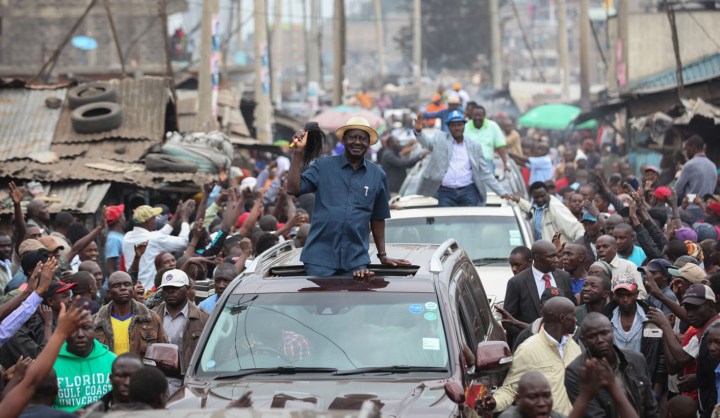Africa
ISS Today: Kenya’s education focus should be on quality, not quantity

Kenyatta’s election promise of free secondary schooling ignores the real problem in education. By Stellah Kwasi for ISS TODAY.
First published by ISS Today
President Uhuru Kenyatta recently announced that if re-elected on 8 August, his government would provide free secondary education by 2019. Kenyatta believes that secondary education at no cost would increase the transition rate from primary to secondary school.
Indeed, primary school enrolment and attendance improved vastly after free primary education was announced in 2001 and rolled out from 2002. Net primary enrolment, according to the International Futures modelling system, stands at 85% today (up from 65% in 2000) and is forecast to reach over 93% by 2030. The number of enrolled primary school pupils making it to the final grade has also risen from 70% in the early 2000s to about 93% today.
Ensuring that more students make it into primary school and stay in school long enough to reach the last grade of primary school is crucial to increasing the pool of students who advance to successive levels.
But access to education may not be the real issue plaguing the education sector – high enrolment rates and full classrooms don’t necessarily translate into knowledge or quality. What Kenyatta’s government really should be focusing on is the quality of Kenya’s education, which lately has come under a lot of scrutiny.
The annual learning assessment report of 2010 released damning findings about the progress of students across the education spectrum. These included revelations that Std 8 pupils couldn’t solve Std 2-level mathematical problems and concepts, and were incapable of reading and writing to their required level.
Furthermore, former education cabinet secretary Jacob Kaimenyi lamented in 2014 that the teacher-student ratio had declined to its worst levels since free primary education was rolled out in 2002.
Despite the findings of the assessment report, in 2014 the transition rate from primary to lower secondary was 98%. However only about 67% of students progressed to upper secondary and only 50% of those students graduated from upper secondary school.
Poverty, low academic achievement and indiscipline have been cited as some of the causes of the high drop-out rates in secondary school – but they aren’t the only challenges. The quality of primary education is a big part of why pupils aren’t completing the secondary level.
There are established methods for raising the quality of education. For one, the teacher-pupil ratio currently ranges from a low of 42:1 – which is well above the 23:1 global average – to an appalling 85:1. This ratio needs to be addressed – more teachers are needed for the number of pupils.
Employing better-qualified teachers and improving teacher training in line with international standards should also be one of the priorities, and would undoubtedly boost the quality of education.
The Kenya Education Sector Support Programme report released in 2013 revealed that although the ratio of pupils to permanent classrooms in public primary schools decreased from 50:1 to 46:1 in 2009, it didn’t reach the target of 40:1. Improved infrastructure like classrooms and better availability of learning supplies could also help raise the quality of education.
Kenya’s government has not adequately addressed these concerns. The government consistently runs into teacher strikes, and each time a less-than-satisfactory solution is found. Secretary-general of the Kenya National Union of Teachers Wilson Sossion expressed happiness after an agreement was reached with teachers during the 2016 strike, but the negotiations on the employment of more educators to address the teacher shortage was not concluded at that time.
Similarly, proposals to improve teacher training, provide more supplies and structures to aid capacity and curriculum reform largely remain empty rhetoric.
The current politically charged climate and euphoria around election time certainly affords the president opportunity to make unrealistic promises. And the timing of the free secondary education announcement raises questions.
But the lack of transparency surrounding financing and the pile of unresolved and pressing issues within the education sector, especially at the primary level, makes this sound more like hot air than a carefully thought-out plan. Kenyatta’s promise comes amid a looming budget deficit.
The president has made similar promises in the past. For example, during the 2012 election campaigns he announced the laptop project, which was criticised by many economists and education experts. They said it lacked any underlying research to show the impact that laptops would have on learning outcomes for students, and came at a high cost to the taxpayer (KES53-billion, or US$600-million, at the time).
Coupled with a lack of procurement mechanisms and confusion about which ministry would be responsible, the project to deliver over 1.3 million laptops had many false starts. It bolsters the notion that the promise for free secondary education may well be empty talk.
Regardless of whether he keeps this promise though, attention should shift to the quality of primary education rather than enrolment to curb the deterioration of Kenya’s education system. DM
Stellah Kwasi, African Futures and Innovation, ISS Pretoria
Photo: Pupils study at a small school in Matondoni village on Lamu island, Kenya, 18 June 2014. EPA/DAI KUROKAWA
















 Become an Insider
Become an Insider